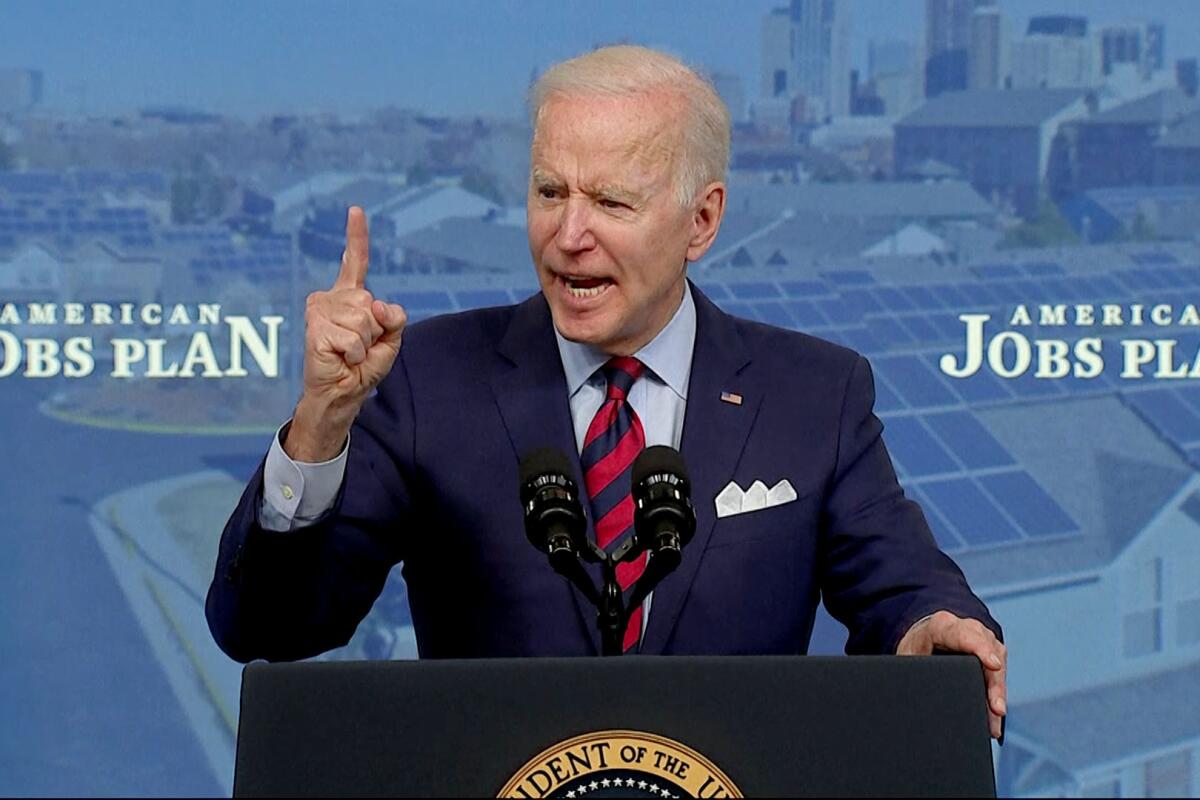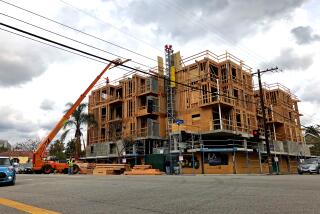Biden targets housing rules that hurt low-income earners. Will the suburbs buy in?

- Share via
WASHINGTON — The enduring image of the American Dream is owning a tidy single-family house behind a white picket fence in the suburbs.
But for many people of color and low-income earners, that part of the American dream is fleeting, in part because of exclusionary zoning laws.
Though the Supreme Court in 1917 struck down explicit racial zoning laws as unconstitutional, exclusionary zoning regulations sprang up in their place, many requiring minimum lot sizes and banning all but single-family homes on residential lands.
Because of the racial wealth gap, “laws that say you can only live in this neighborhood if you can afford a single-family home disproportionately hurt Black and Latino people,” said Richard Kahlenberg, a senior fellow at the Century Foundation, a progressive New York City-based think tank.
(Before the pandemic, Black households’ average wealth was less than 15% of white families’, with Latinos faring only slightly better, according to the Federal Reserve’s 2019 Survey of Consumer Finances.)
Discriminatory regulations contribute to a cataclysmic crisis by “artificially inflating” the cost of homes and limiting the supply of affordable housing, Kahlenberg said. “That’s not the free market at work,” he said.
A push for ‘real equity’
Amid a pandemic-fueled economic downturn and a single-family housing market boom that has largely been accessible only to higher-income earners, President Biden wants to create a $5-billion program to give grants and tax credits to local governments that start to eliminate exclusionary zoning rules.
The proposal, which is part of Biden’s push to address racial equity, is included in his $2-trillion infrastructure plan and would be run out of the Department of Housing and Urban Development. But some advocates worry Biden’s plan has too many carrots and few sticks.
During his speech to a joint session of Congress last month, Biden said the infrastructure plan could help deliver affordable housing and give more Americans “the ability to generate wealth and pass it down to generations because you have an access to purchase a house.” The White House did not respond to a request for comment.
It is unclear how or if Democrats will incorporate eliminating exclusionary zoning in their formal infrastructure bill. Republicans have balked at Biden’s plan and countered with a $568-billion proposal of their own that would not include any funding for housing.
Biden held his first formal White House meeting with House and Senate leaders to discuss infrastructure. Republicans have signaled opposition.
Addressing the broad housing crisis would require more than 7 million affordable housing units for extremely low-income families, according to the National Low Income Housing Coalition, a Washington-based nonprofit.
The percentage of land zoned for single-family housing varies by city. In Los Angeles, 75% of residential land is zoned for detached single-family homes. In Washington, D.C., nearly 60% of residential land is zoned for single-family housing, and 36% of that is for detached homes.
Eliminating exclusionary zoning ordinances has become increasingly popular around the country. Lawmakers in Minneapolis and Oregon in recent years voted to effectively ban single-family zoning. Berkeley’s city council vowed to end single-family zoning by 2022.
Affluent suburbs may need sticks in addition to carrots
Experts say the program outlined by the president has a major flaw — it’s voluntary.
David Dworkin, president and chief executive of the National Housing Conference, a Washington-based nonpartisan advocacy group, said any effort at the local level would face fierce opposition. He described the political pressure to keep “the other out” of single-family neighborhoods as one of the “last bastions of bipartisanship.”
“You see it in Republican strongholds as much as Democratic ones,” he said.
Dworkin suggested tying federal transportation funding to local governments’ reductions in exclusionary zoning.
“If the federal government is going to invest taxpayer dollars into transportation, it’s not unreasonable that money is prioritized for communities doing everything they can to address the causes of long commutes — exclusionary zoning,” Dworkin said. “The people who fix our cars and make our lattes also need to live where they work.”
The Biden administration could bring more lawsuits to challenge discriminatory ordinances under the 1968 Fair Housing Act to “compel change,” Kahlenberg said.
“In addition to carrots, you need sticks for more affluent jurisdictions,” Kahlenberg said.
President Biden directed the Department of Housing and Urban Development to review Trump regulatory actions the administration says undermine the Fair Housing Act.
Kahlenberg said Washington lawmakers could create a new economic fair housing measure that would allow those who have been harmed by exclusionary zoning practices to sue in federal court.
Howard Husock, adjunct policy scholar at the American Enterprise Institute, a conservative Washington-based think tank, said it would be “very unfortunate to make this a confrontational issue.” Husock also argues that luring “insulated” planning boards with money is not a viable option.
Though “more relaxed zoning laws and a wider range of housing types would be good for all income types,” he said, federal agencies should instead show local governments how and why they should lower housing costs — without subsidies or federal involvement.
“Persuasion is the ultimate remedy,” he said.
Protecting the status quo
But persuasion can only go so far with residents content with the status quo.
Stu Kohn, a 74-year-old resident of Howard County, between Baltimore and Washington, does not see the elimination of single-family zoning as a good thing.
“People should have a dream,” Kohn said. “I don’t think it’s right to price people out, and I’m all in favor of affordable housing at any given time. But getting rid of single-family zoning seems extreme.”
Last summer, Baltimore-area home sales hit a record high as inventory slid, according to the Baltimore Sun. Howard County’s median sales price for single-family homes rose by more than 11%.
Only one piece of the puzzle
Debby Goldberg, vice president of housing policy and special projects at the National Fair Housing Alliance, a Washington-based advocacy group, said that while it’s worth “encouraging jurisdictions to change their rules to make a broader range of housing to be built, there is not a commonly agreed-upon definition of which zoning regulations are exclusionary and what is inclusionary.”
Goldberg said many people think of exclusionary zoning as mandating single-family homes on large lots, so, for example, a neighborhood that allows for a duplex on a one-acre lot is seen as less restrictive. “But is that enough?” she asked.
The Biden administration has yet to designate which zoning ordinances it deems exclusionary, according to senior HUD officials.
“While eliminating single-family zoning and increasing density eliminates a barrier, it does not mean there will not still be a housing crisis,” Goldberg said. For example, she said, down payment assistance and eliminating discriminatory policies in the market also need to be simultaneously tackled.
“Zoning is just one piece of this puzzle,” Goldberg said.
More to Read
Get the L.A. Times Politics newsletter
Deeply reported insights into legislation, politics and policy from Sacramento, Washington and beyond. In your inbox twice per week.
You may occasionally receive promotional content from the Los Angeles Times.













